Home gardening inspiration, plus a boxwood garden and Chinese garden: Missouri Botanical Garden, part 4

Visiting Missouri Botanical Garden (MOBOT) earlier this month for the first time, I expected to breeze through the Center for Home Gardening and get on to more interesting parts of the garden. Instead I found myself poking around this space for close to an hour. I was happy to be surprised!
Kemper Center for Home Gardening
What did I expect? Oh, a lackluster example or two of a home-style landscape: a lawn bordered by locally appropriate shrubs, some perennials, and colorful bedding annuals, with a few vegetable garden beds on the side. Lots of signage and not enough plants. Too much open space.
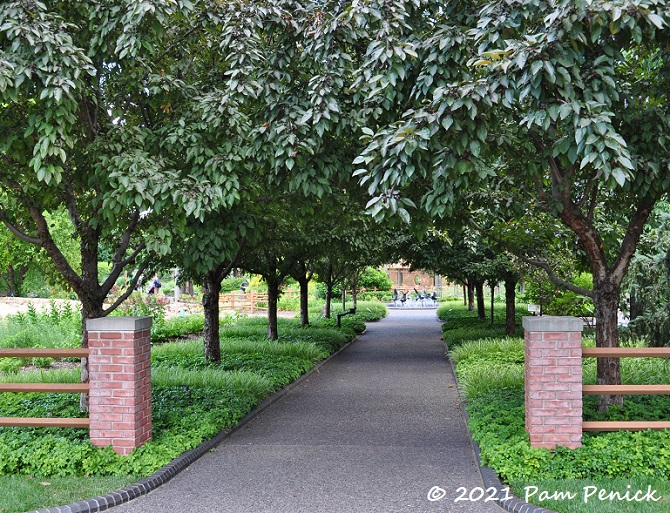
But the Kemper Center includes some dramatic design moments, like this entrance through a crabapple allée (imagine this in spring bloom), leading the visitor to…
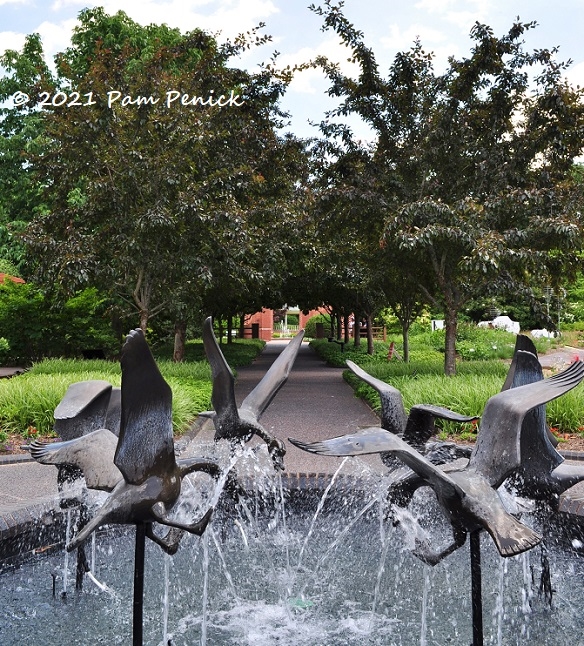
…a humorous fountain of splashing geese.

And then you find yourself walking under a curving, lath-roofed pergola, which offers much-needed shade on a hot day and creates beautifully patterned shadows. Lath screens on one side are inset with oval windows for views of other garden spaces.
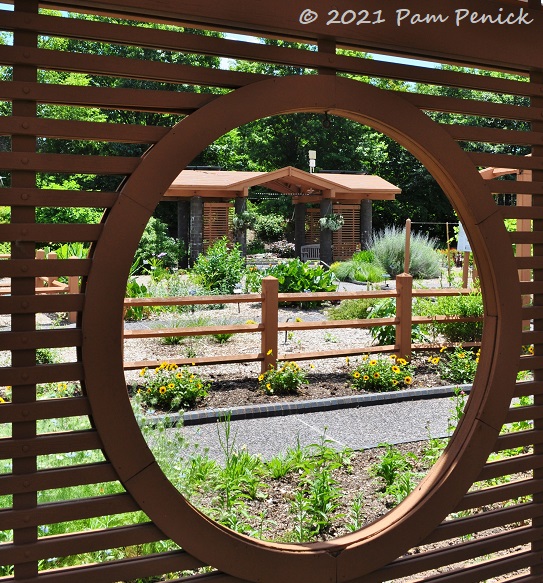
OK, this view is just so-so, but perhaps it’s in transition between spring and summer.

The garden view on the other side, however, is stunning, with color echoes and wonderful textures and lots of interesting plants. Later I traipsed across the lawn to get the ID of the pink-flowering tree pictured in the background of this photo. It’s a tamarisk or saltcedar (Tamarix ramosissima), which unfortunately is designated as a noxious weed in many U.S. states, including Texas and the Midwest. Do not plant, clearly — in which case, why is it featured in a home-gardening demonstration garden? However, it is undeniably beautiful.
Overall the Kemper Center contains 8-1/2 acres of residential display gardens, 23 demonstration gardens, and an 8,000-square-foot pavilion. While the pavilion was closed due to covid precautions during our visit, normally it’s open and staffed with master gardeners and other volunteers available to answer gardening questions — a welcome supplement to MOBOT’s excellent Plant Finder database (click for the link under Gardening Help).

A Flame Thrower redbud — a new-to-me variety with sunset-hued leaves — caught my eye as we headed out.
Origami sculpture

Santa Fe artists Jennifer and Kevin Box are displaying their wonderful origami sculptures in an exhibition called Origami in the Garden. This soaring crane stands in the center of a raised bed of native prairie grasses and wildflowers.


In a micro-meadow of grasses, two origami bison serve as a ghostly reminder of the region’s not-so-distant past.

Boxwood Garden

Nearby, a formal Boxwood Garden beckons. Red-brick walls with round windows framing views into the garden bookend a fountain with dancing vertical sprays of water.

Directly ahead, a handsome pavilion with a bell-shaped verdigris roof nestles alongside a burgundy Japanese maple.

The main garden is a curlicued pattern of boxwood parterres, with groundcovers and perennials planted within. A sign explains that boxwood is notoriously difficult to grow in the Midwest, and indeed it looked like it was suffering from die-back.

But when I asked a woman working in the garden what had happened, she said the boxwood had grown too large and was recently cut back hard. That’s why the interior branches are showing. Soon the boxwood will green up again, she explained.

It’s still pretty to my eyes, almost as if the parterres are outlined in two colors instead of just green.

Up close you see the effect of the cutback more clearly.

Along the walled edge, dappled willow (Salix integra ‘Hakuro-nishiki’) caught my eye. Such a pretty shrub, especially against red brick.

Two are planted on either side of a round pool with a vertical splashing fountain.

Multiple fountains appear throughout this garden, adding the music of water to the formal space.
Chinese Garden

The Chinese Garden was among my favorites during our mid-June visit, with its mix of welcome shade from the hot sun, lovely bridges and pavilions, and Asiatic lilies in jewel-bright bloom.

You enter the garden through a moon gate in an arching white wall.

A shade garden glowing in shades of green sets up a contrast with a soon-to-be-revealed pond view.

Suddenly you’re in a sunny garden, with a beautiful, swoop-roofed pavilion ahead of you, a boulder-strewn pond, and lilies glowing burgundy and apricot.

Freckled, apricot lilies and white rose campion make a lovely combo.

A white marble bridge and wavy white walls make for an even more picturesque view.

Plants grow lushly all around except for an open space where you can view the pond and pavilion.

The garden is modeled, according to its webpage, on “the ‘scholar’s gardens’ of the southern provinces of China, near Nanjing….Designed by Chinese-born architect Yong Pan, this garden is a showplace of extraordinary craftsmanship.”

A paddling mallard added his own beauty to the scene. This massive stone is one of five in the pond that symbolize five sacred mountains in China.

Holey-limestone scholar’s rocks placed throughout the garden are sculptures made by Mother Nature herself.
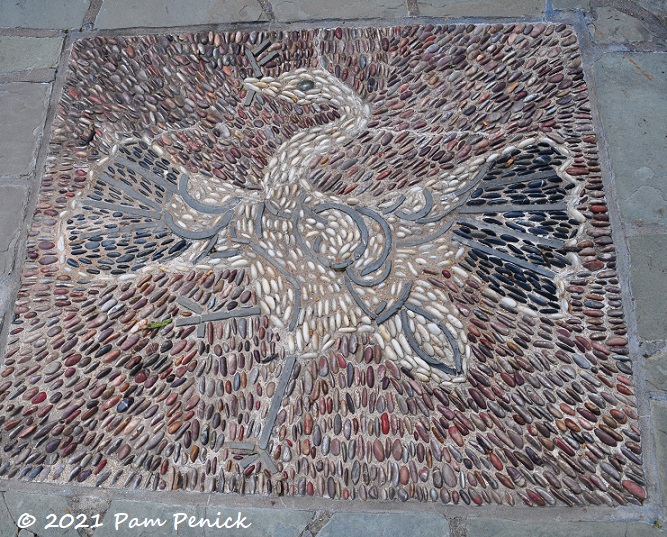
One of the stone mosaics set into the garden’s flagstone paving

The tile-roofed red pavilion beckons as a place to rest and admire the garden.

A curious cardinal on a rock seems almost an intentional color echo.

The marble bridge with its hand-carved balustrades and moon arch
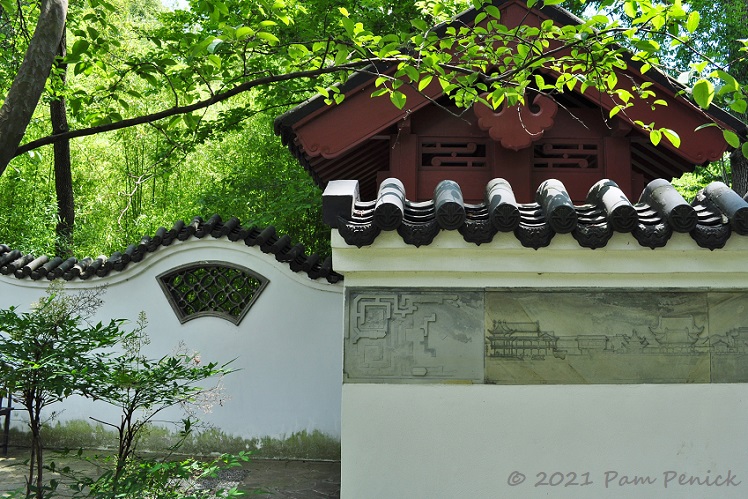
On a wall near the exit, a bas-relief panel of a Chinese city adds one more lovely detail as you leave.
Up next: Exploring the Children’s Garden at MOBOT. For a look back at Seiwa-en, the serene Japanese strolling garden, click here.
__________________________
Digging Deeper
Come learn about gardening and design at Garden Spark! I organize in-person talks by inspiring designers, landscape architects, authors, and gardeners a few times a year in Austin. These are limited-attendance events that sell out quickly, so join the Garden Spark email list to be notified in advance; simply click this link and ask to be added. Season 8 kicks off in fall 2024. Stay tuned for more info!
All material © 2025 by Pam Penick for Digging. Unauthorized reproduction prohibited.



I’m not sure what circumstances might ever bring me to Missouri but I would like to visit that botanic garden. I love the giant origami bison.
Missouri wasn’t on my path to anywhere else either, hence the spontaneous summer road trip. 🙂 Kris, keep an eye out for Origami in the Garden to show up at a public garden in Los Angeles. It’s making the rounds!
Thank you for the beautiful post and pics. I am so glad they cut the boxwood back properly. My personal pet peeve is shrubs not being trimmed correctly with just a few leaves left at the tips because people and yard crews dont want to change the size or are too lazy to do it right. My two cents…
They definitely went for it. I wish I could see before pics to know how large the boxwoods were before the dramatic cutback.
O my goodness. I want to go over there again sometime soon. You have made such a beautiful presentation. Did you see the tower that overlooks the maze and Victorian garden? I wondered if it was still accessible. I got lost in the maze once and had a panic attack trying to find my way out. Now it is funny, but I won’t go back in. I was wondering if it was all still there.
The observation tower’s upper level was closed to visitors, unfortunately. And I didn’t even notice the maze, so if it’s still there I somehow managed to overlook it. That’s a funny story (sort of!) about getting lost in it. You can see pics of that part of the garden in this post: https://www.penick.net/digging/?p=75579
Love those round windows in the lath pergola. Shade is definitely needed in St. Louis in summer.
It certainly was on the day we visited. It wasn’t Texas hot, but it was pretty warm.